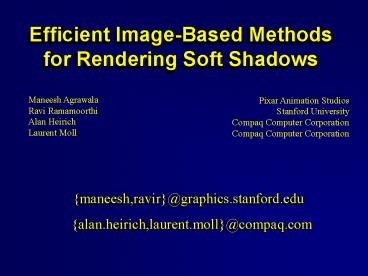Efficient Image-Based Methods for Rendering Soft Shadows - PowerPoint PPT Presentation
Title:
Efficient Image-Based Methods for Rendering Soft Shadows
Description:
Again much of the speedup is due to coherence-based sampling of the light source ... Hard Shadows Soft Shadows Attenuation only With lighting Light Shadow ... – PowerPoint PPT presentation
Number of Views:126
Avg rating:3.0/5.0
Title: Efficient Image-Based Methods for Rendering Soft Shadows
1
Efficient Image-Based Methods for Rendering Soft
Shadows
Maneesh Agrawala Ravi Ramamoorthi Alan Heirich
Laurent Moll
Pixar Animation Studios Stanford
University Compaq Computer Corporation Compaq
Computer Corporation
- maneesh,ravir_at_graphics.stanford.edu
- alan.heirich,laurent.moll_at_compaq.com
2
Hard vs. Soft Shadows
Hard Shadows
Soft Shadows
3
Shadow maps
- Image-based hard shadows Williams 78
- Time, memory depend on image size,
not geometric scene complexity - Disadvantage bias and aliasing artifacts
- Soft shadows Chen and Williams 93
- View interpolate multiple shadow maps
4
IBR good for soft shadows
- IBR good for secondary effects
- Artifacts less perceptible
- IBR works well for nearby viewpoints
- Shadow maps from light source
- Light source localized area
- Poorly sampled regions are also dimly lit
5
IBR good for soft shadows
- Poorly sampled regions are also dimly lit
Shadow map
Light
Attenuation only
With lighting
6
Contributions
- Extend shadow maps to soft shadows
- Image-based rendering especially suitable
- Two novel image-based algorithms
- Layered attenuation maps (LAM)
- Coherence-based raytracing (CBRT)
7
- LAM
- Display 5-10 fps
- Some aliasing artifacts
- Interactive applications
- Games
- Previewing
- CBRT
- Render 19.83 min
- Speedup 12.96x
- Production quality images
8
Refresher LDIs
- Layered depth images Shade et al. 98
9
Refresher LDIs
- Layered depth images Shade et al. 98
LDI
10
Refresher LDIs
- Layered depth images Shade et al. 98
LDI
(Depth, Color)
11
Precomputation
- Render views from points on light (hardware)
- Create layered attenuation map (software)
- Warp views into LDI
- Store (depth, attenuation)
- Objects in LAM visible in at least 1 view
12
Precomputation
1st viewpoint
13
Precomputation
2nd viewpoint
14
Precomputation
Warped 2nd viewpoint
15
Display
- Render scene without shadows (hardware)
- Project into LAM
(software) - Read off attenuation
- Attenuation modulates shadowless rendering
16
Display
LAM (center of light)
Eye
17
Display
LAM (center of light)
Eye
Attenuation 2/2 Color Color 2/2
18
Display
LAM (center of light)
Eye
19
Display
LAM (center of light)
Not in LAM Attenuation 0 Color Color 0
Eye
20
Previous Interactive Methods
- HW per-object textures Herf and Heckbert 97
- Convolution Soler and Sillion 98
- Texture intensive
21
- LAM size 512 x 512
- Avg num depth layers 1.5
- Precomp
- 7.7 sec (64 views)
- 29.4 sec (256 views)
- Display 5-10 fps
22
- LAM size 512 x 512
- Avg num depth layers 2
- Precomp
- 6.0 sec (64 views)
- 22.4 sec (256 views)
- Display 5-10 fps
23
LAM Video
24
- Layered attenuation maps fast, aliases
- Coherence-based raytracing slow, noise
25
Coherence-based raytracing
- Hierarchical raytracing through depth images
- Time, memory decoupled from geometric scene
complexity - Coherence-based sampling
- Light source visibility changes slowly
- Reduce number shadow rays traced
- Also usable with geometric raytracer
26
Image-based raytracing
Light
1st shadow map
- Represent scene with multiple shadow maps
27
Image-based raytracing
Light
1st shadow map
2nd shadow map
- Represent scene with multiple shadow maps
28
Image-based raytracing
Light
1st shadow map
2nd shadow map
- Trace shadow ray through shadow maps
29
Hierarchical img based raytracing
- Previous
- Height fields Musgrave et al. 89
- New views Marcato 98 Chang 98
- Lischinski and Rappoport 98
- Shadows Keating and Max 99
- Our contributions
- Accelerations shadow ray traversal
- Fast methods handling multiple depth images
- Speedup 2.20 x
30
Light source visibility image
s1
31
Light source visibility image
s1
s2
32
Coherence-based sampling
- Compute visibility image at first point s1
- Loop over following surface points si
- Predict visibility image at si from si-1
- Trace rays where prediction confidence low
33
Predicting visibility
Blocker pts
s1
34
Predicting visibility
Blocker pts
s1
35
Prediction confidence
- Low confidence
- Light source edges
- Blocked/unblocked edges
Predicted visibility
36
Prediction confidence
- Low confidence
- Light source edges
- Blocked/unblocked edges
- Trace rays in all Xed cells
- High confidence 56
- Low confidence 88
- Total cells 144
- Ratio 56/144 0.40
Predicted visibility
37
Propagating low confidence
Prediction correct
- Similar to Hart et al. 99
38
Propagating low confidence
Prediction incorrect
- Similar to Hart et al. 99
39
- Light cells 16 x 16 (256)
- Four 1024 x 1024 maps
- Precomp 2.33 min
- Render 19.83 min
- Rays 79.86
- Speedup 12.96x
- 2.27x due to image-based raytracing
accelerations - 5.71x due to coherence-based sampling
40
- Light cells 16 x 16 (256)
- Four 1024 x 1024 maps
- Precomp 3.93 min
- Render 65.13 min
- Rays 88.74
- Speedup 8.52x
- 2.16x due to image-based raytracing
accelerations - 3.94x due to coherence-based sampling
41
LAM
CBRT
42
Conclusions
- Two efficient image-based methods
- Layered attenuation maps
- Interactive applications
- Coherence-based raytracing
- Production quality images
- IBR ideal for soft shadows secondary effects
43
Future work
- Dynamic scenes
- Antialiasing with deep shadow maps
- Hardware implementation
44
Acknowledgements
- Tom Lokovic
- Reid Gershbein, Tony Apodaca, Mark
VandeWettering, Craig Kolb - Stanford graphics group
45
(No Transcript)
46
Prediction errors
- Missed blockers
- Dependent on surface sampling
- density
- Missed holes
- Dependent on light source sampling density
missed blocker
s2
s1

